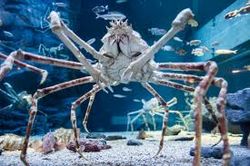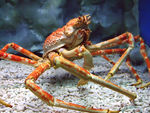Japanese spider crab
| Japanese spider crab |
|---|

|
| Scientific Classification |
|
| Scientific Name |
|
Macrocheira kaempferi |
| Japanese spider crab in aquarium |
The Japanese spider crab is the largest living arthropod of today. Despite its scary appearance the Japanese Spider crab has a gentle disposition.[2] It lives off the east coast of Japan in the pacific ocean.[3] It is hard for fisherman to capture them because of the depth at which they live at. They are called Japanese spider crabs because they look like spiders.[4]
Body Design
The Japanese Spider crab has white spots on its legs, but its body is orange. The size of their bodies is 37 centimeters(15 inches). They can weigh up to 20 kilograms(44 pounds). The span of their legs can reach up to 4 meters(13 feet). [2] Males have long chelipeds. The females' chelipeds are much shorter than the males'. The Japanese spider crab can survive even if it looses three of its walking legs. If it were to loose a leg it has the capability to grow back a leg when it is molting.[5]
Their armored exoskeletons help protect them from its large predators.The Japanese Spider crab uses its bumpy carapace to blend in with the ocean floor to camouflage itself from predators.[6] It also has another way that it camouflages itself from predators that is interesting. Unlike other crabs which place multiple different species and types of different organisms on its carapace the Japanese spider crab only places sponges on its carapace because it has so few predators to camouflage itself from. It takes the sponge(s) to different places and the sponge can possibly provide it with drifting food.[3]They are ectothermic and depend on their external environment for heat.[3]
Life Cycle
The Japanese Spider Crab's mating season is in the early months of spring, from January to March. Even though its early stages of life are well-documented little is known about its mating behavior. They have internal fertilization. The male crabs use their first two chelipeds to insert its sperm, which is held in spermatophores, into the female crab. A female can lay up to 1.5 million eggs in a mating season, but very little young survive.The size of the eggs are about 0.63-0.85 millimeters in diameter. [3] Females carry their eggs on their abdomen until they are ready to hatch.[6] They do this so the mother can oxygenate the eggs by stirring the water around them. When the eggs hatch they are left to take care of themselves.The duration of hatching of the eggs are about 10 days.
The Japanese Spider crab goes thru three larval stages.The two first the stages are zoeal stages and the third stage is a megalopa stage.The best temperature for the larval stages is 15-18 Celsius. The zoeal stages last from 12-37 days. The megalopa stage lasts about 30 days. Only 75% survive the first zoeal stage and only 33% survive the second zoeal stage and the megalopa stage. Japanese Spider crabs in their larval stages are found in shallower waters than the adult Japanese Spider crabs are found. In its natural habitat the Japanese Spider crab can live up to 100 years of age.[3]
Ecology
The natural habitat of the Japanese spider crab Macrocheira Kaempferi is the right side of the Japanese islands, Kyushu and Konshu. They can be found off the coast of the Kii peninsula. They are also found in the Sagami, Suruga, and Tosa bays. They are usually found on the rough and sandy base of the continental shelf. They thrive at a depth of about 150 to 300 meters. although they have been found in depths up to 600 meters, most reside in the latter.They tend to be found in shallower depths of about 50 meters in mating season. Crabs that are of younger ages are mostly found in shallower waters, where the temperature is higher and it is warmer. Adult crabs usually live in waters with temperatures of about 10 degrees Celsius. [3]
The Japanese spider crab is an omnivore and a scavenger. They crawl along the sea floor looking for detritus which is dead and decaying matter.They sometimes eat living plant like kelp.Even though they are large and slow they sometimes hunt for small invertebrates. There are tales of Japanese spider crabs pulling sailors into the depth of the ocean and eating them alive, but they are untrue. Japanese spider crabs have very few predators.[3]
Role in Native Culture
In Japanese culture Macrocheira kaempferi is an important and useful organism. At the appropriate crab fishing seasons the Japanese spider crab is served both raw and cooked as a delicacy. There are many recipes and ways to prepare the crab. [7]
An example of a Japanese spider crab recipe is:
- step 1:kill the crab by poking it through its center point with a skewer or sharp knife and moving it side to side
- step 2:with the crab upside down insert it into rapidly boiling water and start timing the crab at 12 minutes per kilogram
- step 3:when it is finished cooking remove from pan and strain it with a strainer
- step 4:run the crab under water and wait for it to cool
- step 5:set aside the legs and claws, tear the body and shell apart, and scrape meat out of shell into bowl
- step 6:remove and discard pointed gills from center of body
- step 7:cut body in half and remove all of the flesh out of the honeycombed center and insert into a bowl
- step 8:wrap the legs and claws in a tea towel and crack them open with a rolling pin or hammer and pick all the meat out
- step 9:mix the leg and claw meat with the shell meat
- step 10:serve with lemon and black pepper[8]
Video
Video description here....
References
- ↑ Macrocheira kaempferi wikispecies. Web. last modified on 1 November 2015 Author Unknown
- ↑ 2.0 2.1 Japanese Spider Crabs animal corner. Web. Last Accessed on January 4, 2017 Author unknown. Cite error: Invalid
<ref>tag; name "corner" defined multiple times with different content - ↑ 3.0 3.1 3.2 3.3 3.4 3.5 3.6 Riebel, Rachel. Macrocheira kaempferi Animal Diversity Web. Web. Last Accessed Febuary 07, 2017 Cite error: Invalid
<ref>tag; name "diversity" defined multiple times with different content Cite error: Invalid<ref>tag; name "diversity" defined multiple times with different content Cite error: Invalid<ref>tag; name "diversity" defined multiple times with different content Cite error: Invalid<ref>tag; name "diversity" defined multiple times with different content Cite error: Invalid<ref>tag; name "diversity" defined multiple times with different content Cite error: Invalid<ref>tag; name "diversity" defined multiple times with different content - ↑ Japanese Spider crab Georgia aquarium. Web. Last accessed Febuary 7, 2017 Author unknown.
- ↑ Japanese Spider Crabs: Twelve Feet of Legs kids discover.
- ↑ 6.0 6.1 Japanese spider crab Wikipedia Web. Last Accessed on January 4, 2017
- ↑ Macrocheira kaempferi Encyclopedia of Life.Web. Last accessed accessed February 7, 2017 Author unknown
- ↑ Tom Hunt How to cook and prepare a spider crab toms feast. Web. last accessed Febuary 7 ,2017



